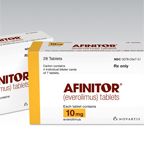BOLERO-3: Adding Everolimus Improves PFS in HER2+ Breast Cancer
The addition of everolimus (Novartis) to combination trastuzumab/vinorelbine leads to a significant improvement in progression-free survival compared with placebo in advanced and metastatic HER2-positive breast cancer.
The addition of everolimus (Novartis) to combination trastuzumab/vinorelbine led to a significant improvement in progression-free survival (PFS) compared with placebo in advanced and metastatic HER2-positive breast cancer, according to results presented at the annual meeting of the American Society of Clinical Oncology.

The addition of trastuzumab to the standard of care in HER2-positive breast cancer has led to significant gains for patients. Unfortunately, in the metastatic setting, the majority of HER2-positive patients eventually experience resistance and relapse. This is thought to result from activation of other growth factor pathways that promote the activation of the PI3K/Akt pathway. A key mediator of this type of signaling is the mammalian target of rapamycin (mTOR) pathway. In preclinical models, inhibition of mTOR using everolimus demonstrated efficacy in trastuzumab-resistant breast cancer.
BOLERO-3 (Breast Cancer Trials of Oral Everolimus-3) is a randomized, double-blind, placebo-controlled multicenter trial designed to assess efficacy of everolimus in combination with trastuzumab and vinorelbine, with a primary endpoint of PFS. Patients with locally-advanced or metastatic trastuzumab-resistant disease with prior taxane therapy were eligible for the study. Trastuzumab resistance was defined as progression within 12 months of trastuzumab treatment. In the metastatic setting, disease was considered resistant if progression occurred within 4 weeks post-treatment. The initial findings were presented by Ruth O'Regan, MD, of Emory University.
A total of 569 patients (median age, 55) completed the trial, recruited from 159 cancer centers in 21 countries worldwide. All patients had received prior trastuzumab therapy; half were undergoing therapy for less than 1 year prior to entering the trial, and the other half had therapy for more than 1 year. Nearly a quarter of the patients had prior lapatinib therapy.
The primary endpoint of PFS was met by the study, with PFS of the everolimus arm reaching 7 months compared to 5.78 months for the placebo arm, for a hazard ratio of 0.78, representing a significant improvement (P = .0067). The majority of groups favor the addition of everolimus, especially patients younger than 65 years of age (HR = 0.77). Prior neoadjuvant trastuzumab therapy was shown to be indicative of success using everolimus (HR = 0.65 compared with patients receiving no prior trastuzumab, HR = 0.92). Patients on lapatinib showed no difference in terms of response (HR = 0.79 for neoadjuvant lapatinib vs HR = 0.78 for no prior lapatinib). Patients lacking visceral involvement showed markedly greater benefit from the addition of everolimus than patients who had visceral disease (HR = 0.48 vs HR = 0.89).
Secondary endpoint data at the time of the presentation were still immature. Overall response rate for the everolimus arm was 40.8% compared to 37.2% in the placebo arm, which did not reach significance (P = .2108). Clinical benefit rates of 59.2% and 53.3% for the everolimus and placebo arms, respectively, also failed to reach significance (P = .0945). As of March 15, 2013, 220 deaths had been recorded, 36.3% of which occurred in the everolimus arm compared with 41.4% in the control arm. The difference failed to reach significance in the interim analysis, and the final overall survival will be assessed once the number of patient deaths reaches 384.
The adverse event profile experienced by patients on everolimus was unsurprising. Patients experienced a higher rate of stomatitis, pyrexia, and decreased appetite compared with placebo. Hematologic toxicities like neutropenia, anemia, febrile neutropenia, and thrombocytopenia were elevated in the everolimus arm, as well. Despite the increased rate of adverse events, the time to deterioration of global health status was not significantly different in the two arms. “The additional toxicity noted for everolimus did not significantly impact quality of life,” remarked Dr. O'Regan.
In conclusion, while the overall survival data were still immature, addition of everolimus to trastuzumab/vinorelbine produced clear benefit in terms of progression-free survival for trastuzumab-resistant, advanced HER2-positive breast cancer.